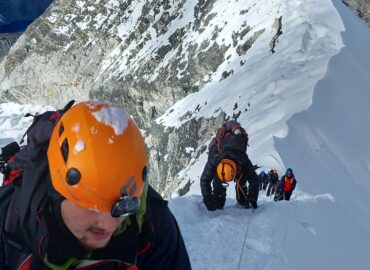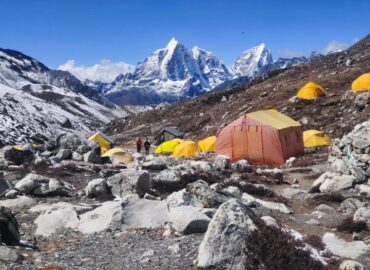- info@destinationholidaytrek.com
- +977-9768913779
- Gokarneshwor-6, Arubari, Kathmandu, Nepal
Island peak Climbing
Island Peak (Imja Tse)
Island Peak, locally known as Imja Tse (6,189m), is one of Nepal’s most popular trekking peaks, offering an ideal introduction to Himalayan mountaineering. Located in the heart of the Khumbu region, close to Everest, the peak stands like an island surrounded by glaciers—hence its name.
This climb combines technical training, glacier travel, fixed ropes, and a final summit ridge that rewards climbers with breathtaking views of Lhotse, Makalu, Baruntse, Ama Dablam, and the entire Imja glacier basin.
Why Island Peak?
◉Perfect for beginners aiming for their first Himalayan summit
◉Combines trekking + mountaineering in one journey
◉Close to Everest Base Camp (can be combined with EBC trek)
◉High success rate with proper acclimatization
🌟 HIGHLIGHTS OF ISLAND PEAK (6,189m)
1. One of Nepal’s most popular trekking peaks — ideal for beginner to intermediate climbers.
2. Summit views of Everest, Lhotse, Makalu, Baruntse & Ama Dablam — truly breathtaking 360° panorama.
3. Excellent mountaineering introduction — includes glacier travel, basic ice climbing, and rope techniques.
4. Climb through the beautiful Imja Valley, surrounded by stunning Himalayan landscapes.
5. Challenging yet achievable peak, perfect for fit trekkers seeking their first Himalayan summit.
6. Thrilling summit ridge with a rewarding final push to the top.
Key Facts
⛰️Altitude: 6,189 meters
📍Region: Khumbu / Everest
⭐Difficulty: Intermediate (requires basic climbing training)
🌤️Season: March–May & September–November
🏁Starting/Ending Point: Lukla
📅Duration: 18–20 days (depending on itinerary)
ITINEARY
- Pick-up from airport and transfer to hotel
- Briefing and gear check
- Overnight in Kathmandu
- Flight: ~35 minutes
- Trek: 3–4 hours
- Easy walk through villages and forests
- Overnight in Phakding
- Trek: 5–6 hours
- First view of Everest if weather is clear
- Steep climb to Namche
- Overnight in Namche
-
- Short hike to Everest View Hotel or Khumjung village
- Explore Sherpa culture and museums
- Overnight in Namche
-
- Trek: 5–6 hours
- Visit Tengboche Monastery with views of Ama Dablam
- Overnight in Tengboche
- Duration: 4–5 hours
- Highlights: Alpine scenery, yak pastures, sparse vegetation
- Overnight: Teahouse in Yak Kharka
- Half-day hike for acclimatization
- Rest in the afternoon
- Overnight in Dingboche
- Trek: 3–4 hours
- Prepare for Island Peak
- Overnight in Chhukung
- Trek: 3–4 hours
- Climbing training in the afternoon (crampons, ropes, etc.)
- Overnight at Base Camp (tent)
- Final preparation, gear checks
- Optional hike around base camp
- Overnight in tent
- Start early (midnight)
- 10–14 hours total (summit and return)
- Technical climb (ice, rope sections)
- Overnight in Chhukung or Base Camp
-
- Buffer in case of bad weather or extra rest needed
- Overnight in Chhukung or Base Camp
- Trek: 5–6 hours
- Retrace steps
- Overnight in Pangboche
- Trek: 6–7 hours
- Downhill and beautiful trail
- Overnight in Namche
- Trek: 6–7 hours
- Final trekking day
- Celebration dinner
- Overnight in Lukla
- Morning flight back
- Free day in Kathmandu
- Overnight in hotel
- Optional sightseeing or shopping
- Spare day in case of flight delays
- Overnight in Kathmandu
- Transfer to airport
- Farewell and departure
Cost ncludes
 Airport Services:
Airport Services:
- Airport pick-up and drop-off (international and domestic) in a private vehicle
- Welcome dinner in Kathmandu with traditional Nepali food
 Accommodation:
Accommodation:
- 3 nights hotel in Kathmandu with breakfast (standard 3-star category)
- Teahouse/lodge accommodation during the trek
- Tented camp during Island Peak base camp stay (with all equipment provided)
 Transportation:
Transportation:
- Kathmandu to Lukla and Lukla to Kathmandu flight tickets (for clients and guide)
- Ground transport for all necessary transfers
 Meals:
Meals:
- All meals (breakfast, lunch, dinner) during the trek and climbing period
- Hot drinks: tea/coffee three times a day
- Seasonal fresh fruits during the trek
 Permits and Fees:
Permits and Fees:
- Island Peak climbing permit
- Sagarmatha National Park entry permit
- Khumbu Pasang Lhamu Rural Municipality fee
- TIMS Card (Trekkers’ Information Management System)
 Climbing and Trekking Staff:
Climbing and Trekking Staff:
- Professional and licensed English-speaking climbing guide
- Assistant Sherpa/climbing guide (as required)
- Experienced trekking guide and porters (1 porter for 2 clients)
- All staff insurance, equipment, food, lodging, and salary
 Climbing Equipment:
Climbing Equipment:
- Group climbing gear (rope, ice screw, snow bar, carabiner, tent, etc.)Personal climbing gear rental can be arranged on request (extra cost)
 Safety and Support:
Safety and Support:
- First Aid medical kit
- Emergency oxygen and satellite phone (pay per use)
- 24/7 support during the trip
Excluded
Island Peak Climbing – Cost Does Not Include
(✘) International Travel:
- International airfare to/from Kathmandu
- Nepal entry visa fee (can be obtained on arrival at the airport)
(✘) Personal Expenses:
- Lunch and dinner in Kathmandu (except welcome/farewell dinner)
- Alcoholic beverages, soft drinks, bottled water, snacks
- Hot shower, battery charging, Wi-Fi, and internet during the trek (in lodges/teahouses)
(✘) Insurance and Emergency:
- Travel insurance (must include emergency evacuation and high-altitude coverage)
- Personal medical expenses
- Helicopter evacuation (if needed – covered by your insurance)
(✘) Equipment and Gear:
- Personal climbing gear (crampons, boots, harness, ice axe, etc.)
- Sleeping bag and down jacket (can be rented in Kathmandu)
(✘) Gratuities:
- Tips for trekking and climbing staff (guide, porter, etc.) – recommended but not mandatory
(✘) Other:
- Any extra night accommodation in Kathmandu due to early return or delay
- Any cost arising due to natural calamities, flight delays, strikes, or other unforeseen events
- Any other expenses not mentioned in the “Cost Includes” section
Itinerary
- Pick-up from airport and transfer to hotel
- Briefing and gear check
- Overnight in Kathmandu
- Flight: ~35 minutes
- Trek: 3–4 hours
- Easy walk through villages and forests
- Overnight in Phakding
- Trek: 5–6 hours
- First view of Everest if weather is clear
- Steep climb to Namche
- Overnight in Namche
-
- Short hike to Everest View Hotel or Khumjung village
- Explore Sherpa culture and museums
- Overnight in Namche
-
- Trek: 5–6 hours
- Visit Tengboche Monastery with views of Ama Dablam
- Overnight in Tengboche
- Duration: 4–5 hours
- Highlights: Alpine scenery, yak pastures, sparse vegetation
- Overnight: Teahouse in Yak Kharka
- Half-day hike for acclimatization
- Rest in the afternoon
- Overnight in Dingboche
- Trek: 3–4 hours
- Prepare for Island Peak
- Overnight in Chhukung
- Trek: 3–4 hours
- Climbing training in the afternoon (crampons, ropes, etc.)
- Overnight at Base Camp (tent)
- Final preparation, gear checks
- Optional hike around base camp
- Overnight in tent
- Start early (midnight)
- 10–14 hours total (summit and return)
- Technical climb (ice, rope sections)
- Overnight in Chhukung or Base Camp
-
- Buffer in case of bad weather or extra rest needed
- Overnight in Chhukung or Base Camp
- Trek: 5–6 hours
- Retrace steps
- Overnight in Pangboche
- Trek: 6–7 hours
- Downhill and beautiful trail
- Overnight in Namche
- Trek: 6–7 hours
- Final trekking day
- Celebration dinner
- Overnight in Lukla
- Morning flight back
- Free day in Kathmandu
- Overnight in hotel
- Optional sightseeing or shopping
- Spare day in case of flight delays
- Overnight in Kathmandu
- Transfer to airport
- Farewell and departure






